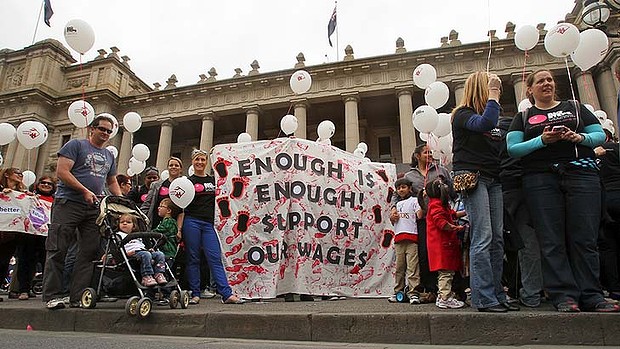by Ned K.
On Saturday 17 November, thousands of Early Childhood Educators, parents and young children took to the streets of capital cities around Australia.
They are campaigning for professional rates of pay. A trained Early Childhood Educator earns as little as $18 per hour, which is an insult given the level of responsibility and skill required in their jobs.
In Adelaide (above) about 3,500 people walked from the main city square to Elder Park, all dressed in red and carrying balloons. Workers from the sector spoke passionately about their love for their jobs and their despair at the poor pay. Parents spoke out in support of them, recognising that early childhood is the time when their children develop important motor and social skills, while older children are prepared for school life.
One speaker summed it up by repeating the words of Gough Whitlam nearly forty years to the day –“It’s Time”. Only this time, it is the Labor Government that has to do the listening to those saying “It’s Time”.
The workers and their supporters are demanding an injection of federal government funding of $1.4 billion per year to enable professional rates of pay to become a reality. With an election due in 2013, political parties ignore the united voice of these workers and families at their peril.
Women workers organising
The vast majority of Early Childhood Educators are women, some starting out in a chosen career, while others return to the sector to work after having brought up young families themselves.
For the working class movement as a whole, many lessons can be learned from them. Twenty years ago they did not even have an award to prescribe minimum conditions for the sector. They mobilised and took to the streets and won a Child Care Workers Award. In the first decade of the twenty first century, they campaigned for and won better staff to child ratios. Now they are campaigning for respect and recognition for the work they do.
The nature of their work makes them great communicators and resilient, manifested by their ability to develop organisation, not only within the sector but in the communities where the child care centres are located.
(Above: childcare workers, Melbourne)
Through all the years of anti-worker legislation from the mid 1990’s to the present day, they maintained their basic workplace organisation through strong union membership and workplace leaders. They even convinced their child care centre co-ordinators that it was in their interests to support the campaign. In this sense within their own centres and across the sector and community they have put in to practice “uniting all who can be united” to win.
Throughout the campaign, these women have been fully supported by their union leaders, United Voice; so refreshing to see as what a fighting union can do, and a stark contrast from the dead hand of the most publicised union at the moment, the HSU.
It’s Time!
When 90% of a child’s brain development occurs under the age of five and 1.3 million children attend child care centres, is it any wonder that Early Childhood Educators responsible for these children are saying it’s time they were respected and recognised?
They have and deserve widespread community support.



Very Informative post On Childcare.Thanks for taking the time to sharing with us.
ReplyDeleteAwesome blog over here! Thanks for sharing this very useful information On Childcare. I will visit your blog again in a couple of days to check if you have some new articles
ReplyDelete